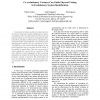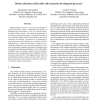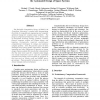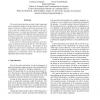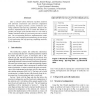EH
2005
IEEE
14 years 8 months ago
2005
IEEE
Co-evolution of system models and system tests can be used for exploratory system identification of physical platforms. Here we demonstrate how the amount of physical testing can ...
EH
2005
IEEE
14 years 8 months ago
2005
IEEE
Manufacturing processes are a key source of faults in complex hardware systems. Minimizing this impact of manufacturing uncertainties is one way towards achieving fault tolerant s...
EH
2005
IEEE
14 years 8 months ago
2005
IEEE
The Evolvable Computation Group, at NASA’s Jet Propulsion Laboratory, is tasked with demonstrating the utility of computational engineering and computer optimized design for com...
EH
2005
IEEE
14 years 8 months ago
2005
IEEE
The structure and operation of multi-cellular organisms relies, among other things, on the specialization of the cells’ physical structure to a finite set of specific operatio...
EH
2005
IEEE
14 years 8 months ago
2005
IEEE
After a reminder about embryonic machines endowed with universal construction and universal computation properties, this paper presents a novel architecture providing additional s...
EH
2005
IEEE
14 years 8 months ago
2005
IEEE
Evolutionary Design has demonstrated great potential to automatically generate a wide array of novel, interesting, and human-competitive designs. Few of these evolved designs, how...
EH
2005
IEEE
14 years 8 months ago
2005
IEEE
In this paper we describe novel metrics measuring complexity in self-organising networks. The metrics are investigated within the context of decentralised inspections, developed a...
EH
2005
IEEE
14 years 8 months ago
2005
IEEE
This paper proposes an original approach to the reliability analysis for Embryonics [4], by introducing the accuracy threshold measure, borrowed from fault-tolerant quantum comput...
EH
2005
IEEE
14 years 8 months ago
2005
IEEE
This paper describes novel concepts of space bionanorobotic systems that are based on revolutionary bio-nano-mechanisms formed by protein and DNA based nano-components. Nano-robot...
EH
2005
IEEE
14 years 8 months ago
2005
IEEE
The hybrid redundancy structure found at the cellular level of higher animals provides complex organism with the three key features of a reliability-engineered system: fault toler...
